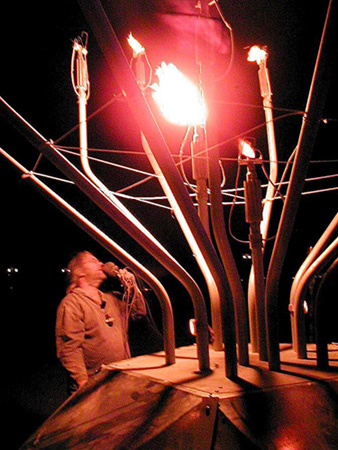| ORDER/SUBSCRIBE SPONSORS CONTACT WHAT'S NEW INDEX/SEARCH HOME | |||||
The Leonardo GalleryThe Voice of Fireby Tim Black
The goal of my artwork has always been to provoke a sense of disbelief. To use technology to do a thing, but leave viewers with only a sense of wonder. To achieve this, for the Burning Man 2003 theme, "Beyond Belief" I wanted to do something that had a religious reference (God talking to Moses from the burning bush) and at the same time was literally beyond belief. In this case, for example, hearing voices from a flame, which is not something you would normally understand as possible and thus was born The Voice of Fire. To present this as a practical effect, I set out to create a sort of burning bush, with voices coming directly from the flames. The end result was a faceted five-sided base with 13 burner pipes coming out the top and spreading like a vary abstract flower. A flame extends about a foot from each pipe and different voices come from each flame. You can walk up and talk to the device, your own voice will echo back through the fire with 13 different time delays. When you stop talking, the voices of all the other people who have talked to it come out in a cacophony of sound. The sound comes directly from the flames, there are no speakers of any kind. It's an old effect, first published in Popular Electronics in 1969. Take a gas burner, add some kind of salt to ionize the fire, pass electricity though the center of the flame, and sound comes out. To see if this really worked, I got a propane torch, a wine bottle filled with salt water, a wick, a 500 volt power supply, the transformer from a microwave oven, a car amplifier, a CD player, and two tungsten welding rods. After a little fooling about, I had music coming from the fire. As to how it sounded, I discovered if the flame was blown around by the air, the sound would waver and cut out, there was not a lot of bass, but other than that, it was just like a speaker. I knew the effect worked, and the adventure to use it began. After studying the effect for months I found it was very tricky to make it reliable. The amount of ion additive was critical, too little and no current flowed, too much and you shorted the effect out. The best sound came from adding just enough ions for 1,000 volts per inch of fire to conduct a few milliamps without arcing. The core of my flames was about 6 inches, so I needed 6000 volts to produce the sound. I collaborated with an audio artist named Simran Gleason (E-mail: simran at art dot net; www.art.net/simran) to get the 13 audio channels. He used a Mac PowerBook and a professional firewire audio interface to record and playback the voices. I built a sealed box with thermoelectric coolers to hold the computer and the other control electronics. After much effort, this part all worked perfectly. For the short time that the Voice of Fire did work, people who encountered it were often speechless and looked puzzled. After hearing the Voice of Fire, they reacted with "that's the damndest thing I've ever seen," or, "What was that? What just happened?" The entire propane-fire effect package and its accompanying electronics were installed in one of the worst environments known to man. What could possibly go wrong? Well, the ever-pervasive playa dust got into the saltwater injectors. In spite of a full recycling filtration system, the entire plumbing got clogged. Without the correct ionization, the flames did not make much sound and I was very disappointed with the result. Of course, when I got it back home and cleaned it out, it worked fine. I took it apart and put it in storage, where it awaits a kinder venue for its next performance. | |||||
|
Updated 17 April 2007. |
|||||









